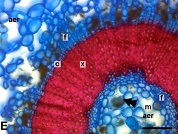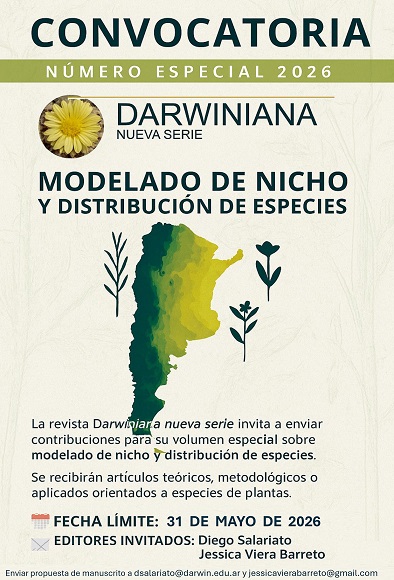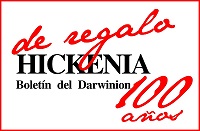Morfo-anatomía e histoquímica de órganos vegetativos de Lycium humile (Solanaceae): rasgos adaptativos a humedales salinos de altura
DOI:
https://doi.org/10.14522/darwiniana.2023.112.1151Palabras clave:
Anatomía, estrategia adaptativa, histología, Lycium, morfologíaResumen
Lycium humile Phil., es una planta halófita extrema, endémica de Argentina, Bolivia y Chile, que crece entre los 2000 y 4000 m s.m. en humedales salinos. El objetivo del presente trabajo es identificar caracteres adaptativos, morfo-anatómicos e histoquímicos de órganos vegetativos de L. humile relacionados a su tolerancia a ambientes extremos de humedales salinos de altura, con el fin de evaluar su potencial como fuente de metabolitos de interés comercial o de genes relacionados a la tolerancia a factores abióticos. Para llevar a cabo el análisis, durante el periodo de febrero 2018, se obtuvieron muestras de plantas pertenecientes a 4 poblaciones (5 individuos por población) ubicadas en los departamentos de Antofagasta de la Sierra, Santa María y Ambato en la provincia de Catamarca, Argentina. Hojas y tallos se estudiaron mediante técnicas histológicas convencionales y análisis histoquímicos para microscopia óptica. Se realizaron también estudios de composición elemental de diferentes tejidos foliares mediante microscopía electrónica de barrido acoplada a espectroscopia elemental de difracción de rayos X (EDX). Las hojas y tallos de las poblaciones estudiadas mostraron características anatómicas e histoquímicas uniformes. Se describe por primera vez cómo se alcanza la suculencia de las hojas por el plegamiento de los tejidos evidenciado en un patrón de venación tridimensional. Se destaca la presencia de mesófilo isolateral-radial y parénquima acuífero como caracteres únicos para la especie. Se evidencian tricomas glandulares y parénquima en empalizada con contenidos complejos de fenoles, flavonoides, proteínas, lípidos, terpenos y alcaloides; así como depósitos de fenoles, lípidos y terpenos en la capa externa de la cutícula. El análisis EDX mostró idioblastos cristalíferos ricos en contenidos de Ca2+ y Na+. Los tallos se caracterizaron por presentar hipodermis y cámaras de aire en los estratos corticales y medulares. Estos caracteres anatómicos e histoquímicos de L. humile representan rasgos adaptativos a ambientes salinos de humedales de altura. Se discute su función en relación al ambiente y su potencial como fuente de genes de resistencia y de metabolitos interesantes para la industria cosmética y farmacéutica.
Citas
Ahammed, G. J.; Y. Li, X. Li, W. Y. Han & S. Chen. 2018. Epigallocatechin-3-gallate alleviates salinity-retarded seed germination and oxidative stress in tomato. Journal of Plant Growth Regulation 37: 1349-1356. DOI: https://doi.org/10.1007/s00344-018-9849-0
Ahmad, K. J. 1964 a. Cuticular studies in Solanaceae. Canadian Journal of Botany 42: 793-863. DOI: https://doi.org/10.1139/b64-071
Alam, P.; T. H. Albalawi, F. H. Altalayan, M. A. Bakht, M. A. Ahanger & V. Raja. 2019. 24-Epibrassinolide (EBR) confers tolerance against NaCl stress in soybean plants by up-regulating antioxidant system, ascorbate-glutathione cycle, and glyoxalase system. Biomolecules 9(11): 640. DOI: https://doi.org/10.3390/biom9110640
Apóstolo, N. M. 2005.Caracteres anatómicos de la vegetación costera del Río Salado (Noroeste de la provincia de Buenos Aires, Argentina). Boletín de la Sociedad Argentina de Botánica 40 (3-4): 215-227.
Baas, P. & S. Carlquist. 1985. A comparison of the ecological wood anatomy of the floras of Southern California and Israel. IAWA Journal 6: 349-353. DOI: https://doi.org/10.1163/22941932-90000961
Bahamondes, P.; P. Medina & J. Mella 2012. Guía de Campo: Flora y Fauna en Michilla, El Tesoro y Esperanza, en F. F. Novoa & M. Contreras (eds.), Ediciones del Centro de Ecología Aplicada Ltda. Chile.
Ben Saad, R; N. Zouari, W. Ben Ramdhan, J. Azaza, D. Meynard, E. Guiderdoni & A. Hassairi. 2010. Improved drought and salt stress tolerance in transgenic tobacco overexpressing a novel A20/AN1 zinc-finger “AlSAP” gene isolated from the halophyte grass Aeluropus littoralis. Plant Molecular Biology 72: 171-190. DOI: https://doi.org/10.1007/s11103-009-9560-4
Bendjedou, H.; L. Barboni; F. Maggi; M. Bennaceur & H. Benamar. 2021. Alkaloids and sesquiterpenes from roots and leaves of Lycium europaeum L. (Solanaceae) with antioxidant and anti-acetylcholinesterase activities. Natural Product Research 35(16): 2784-2788. DOI: https://doi.org/10.1080/14786419.2019.1666386
Bernardello, G. 2013. Lycium. en F. Zuloaga, M. Belgrano & A. Anton (eds) Flora Argentina: Vol 13, Solanaceae. IBODA-IMBIV, CONICET, San Isidro, pp. 47-75.
Bernardello, L. M. 1982. Estudios en Lycium (Solanaceae). I. Anatomía de hoja y tallo, y sus diferencias con Grabowskia. Boletín de la Sociedad Argentina de Botánica 21: 153-185.
Cabrera, A. L. 1957. La vegetación de la Puna argentina. Revista de Investigaciones Agrícolas 4: 317-412.
Carilla, J.; A. Grau & A. S. Cuello. 2018. Vegetación de la Puna Argentina, en H. R. Grau; M. J. Babot; A. E. Izquierdo & A. Grau (eds) La Puna argentina: Naturaleza y cultura. Serie Conservación de la Naturaleza 24. Fundación Miguel Lillo, Tucumán, Argentina.
Carraro, E., & A. Di Iorio. 2022. Eligible strategies of drought response to improve drought resistance in woody crops: a mini-review. Plant Biotechnology Reports 16: 265-282. DOI: https://doi.org/10.1007/s11816-021-00733-x
Cordero, S.; F. Gálvez & L. Abello. 2020. Usos tradicionales de la flora de Chile. Volumen I, Nativas. Ediciones Botánicas, Editorial Planeta de Papel Ltda. Valparaíso, Chile.
D’Ambrogio de Argüeso, A. 1986. Manual de Técnicas en Histología Vegetal. Editora Hemisferio Sur S. A., Buenos Aires, Argentina.
David, R. & J. P. Carde. 1964. Coloration differentielle des inclusions lipidique et terpeniques des pseudophylles du Pin maritime au moyen du reactif Nadi. Comptes rendus de l’Académie des Sciences 258: 1338-1340.
Di Rienzo, J. A.; F. Casanoves, M. G. Balzarini, L. Gonzalez; M. Tablada & C. W. Robledo. 2015. InfoStat versión 2015. Grupo InfoStat. FCA, Universidad Nacional de Cordoba. https://www.infostat.com.ar
Dizeo de Strittmatter, C. G. 1973. Nueva técnica de diafanización. Boletín de la Sociedad Argentina de Botánica 15 (1): 126-129.
Ellis, B. D.; C. Daly, L. J. Hickey, H. R. Johnson, J. D. Mitchell, P. Wilf & S. L. Wing. 2009. Manual of leaf architecture. Cornell University Press, USA.
Fahn, A. & Cutler, D. 1992. Xerophytes. Encyclopedia of plant anatomy. Gebruder, Borntraeger, Berlin.
Farías, M. E. 2020. Microbial ecosystems in Central Andes extreme environments. Springer, Cham. Springer Nature Switzerland. DOI: https://doi.org/10.1007/978-3-030-36192-1
Fernández, R. D.; O. Varela & P. L. Albornóz. 2016. Anatomía de hoja, tallo y raíz de Halophytum ameghinoi (Halophytaceae), especie endémica de Argentina. Lilloa 53(1): 23-31. https://www.lillo.org.ar/journals/index.php/lilloa/article/view/119
Fernández, Y. T.; O. Diaz, E. Acuña, M. Casanova, O. Salazar & A. Masaguer. 2016. Phytostabilization of arsenic in soils with plants of the genus Atriplex established in situ in the Atacama Desert. Environmental Monitoring and Assessment 188: 235. DOI: https://doi.org/10.1007/s10661-016-5247-x
Figueroa, M. E. & A. M. Giménez. 2015. Consideraciones ecológicas sobre una población de Lycium athium (Solanaceae) y ampliación de su área de distribución. Boletín de la Sociedad Argentina de Botánica 50 (1): 79-91.
Flowers, T. J. & T. D. Colmer. 2015. Plant salt tolerance: adaptations in halophytes. Annals of Botany 115 (3): 327-331. DOI: https://doi.org/10.1093/aob/mcu267
Galetto, L.; G. Bernardello & C. A. Sosa. 1998. The relationship between floral nectar composition and visitors in Lycium (Solanaceae) from Argentina and Chile: what does it reflect?. Flora 193: 303-314. DOI: https://doi.org/10.1016/S0367-2530(17)30851-4
Gonçalves, L. C. 2018. Avaliação do potencial genotóxico e antigenotóxico de Lycium barbarum (goji berry), nutracêutico usado como citoprotetor e antioxidante. Tesis doctoral, Universidade Estadual Paulista “Júlio de Mesquita filho. Disponible en: https://hdl.handle.net/11449/153539
Grigore, M. N. & C. Toma. 2008. Ecological anatomy investigations related to some halophyte species from Moldavia. 4th WSEAS international conference on mathematical biology and ecology (MABE’08) Acapulco, Mexico: 25-27.
Grigore, M. N. & T.Constantin. 2017. Succulence, en M. N. Grigore & T.Constantin (eds), Anatomical Adaptations of Halophytes. Springer, Cham. DOI: https://doi.org/10.1007/978-3-319-66480-4_3
Hagemeyer, J. 1997. Salinization a problem of global scale, en: M. Prassad (ed), Plant ecophysiology, John Willey y Sons Inc., New York.
Hamrick, J. L. & M. W. Godt. 1996. Effects of life history traits on genetic diversity in plant species. Philosophical Transactions of the Royal Society of London. Series B: Biological Sciences 351: 1291-1298. DOI: https://doi.org/10.1098/rstb.1996.0112
Hashem, H. A., & Mohamed, A. H. (2020). Strategies for drought tolerance in xerophytes. Plant ecophysiology and adaptation under climate change: mechanisms and perspectives I: general consequences and plant responses, 269-293. DOI: https://doi.org/10.1007/978-981-15-2156-0_9
Heinrich, M.; J. Mah & V. Amirkia. 2021. Alkaloids used as medicines: Structural phytochemistry meets biodiversity - An update and forward look. Molecules 26: 1836. DOI: https://doi.org/10.3390/molecules26071836
Hernandes-Lopes, J.; M. A. Oliveira-Neto & G. F. A. Melo-de-Pinna GFA. 2016. Different ways to build succulent leaves in Portulacineae (Caryophyllales). International Journal of Plant Sciences 177: 198-208. DOI: https://doi.org/10.1086/684178
Heslop-Harrison, J. & Y. Heslop-Harrison. 1981. The pollen-stigma interaction in the grasses. 2. Pollen-tube penetration and the stigma response in Secale. Acta Botanica Neerlandica 30: 289-307. DOI: https://doi.org/10.1111/j.1438-8677.1981.tb00410.x
Heyduk, K. 2021. The genetic control of succulent leaf development. Current Opinion in Plant Biology 59: 101978. DOI: https://doi.org/10.1016/j.pbi.2020.11.003
Heyduk, K.; M. R. McKain, Lalani F. & J. Leebens-Mack. 2016. Evolution of CAM anatomy predates the origins of Crassulacean acid metabolism in the Agavoideae (Asparagaceae). Molecular Phylogenetics and Evolution 105: 102-113. DOI: https://doi.org/10.1016/j.ympev.2016.08.018
Hickey, L. J. 1979. A revised classification of the architecture of dicotyledonous leaves, en C. Metcalfe & L. Chalk L. (eds), Anatomy of the Dicotyledons, Clarendon Press, Oxford.
Jáuregui, D.; M. Castro, T. Ruiz-Zapata & M. Lapp. 2019. Estructura anatómica de los órganos vegetativos de Blutaparon vermiculare (Amaranthaceae) y Funastrum glaucum (Apocynaceae), especies que crecen en las zonas costeras venezolanas. Rodriguésia 70: e02582017.
Johansen, D. A. 1940. Plant Microtechnique. McGraw-Hill, New York, NY, USA.
Kumar, S.; M. M. Abedin, A. K. Singh & S. Das. 2020. Role of phenolic compounds in plant-defensive mechanisms. Plant Phenolics. Sustainable Agriculture 1: 517-532. DOI: https://doi.org/10.1007/978-981-15-4890-1_22
Levin, R. A. & J. S. Miller. 2005. Relationships within tribe Lycieae (Solanaceae): paraphyly of Lycium and multiple origins of gender dimorphism. American Journal of Botany 92: 2044-2053. DOI: https://doi.org/10.3732/ajb.92.12.2044
Levin, R. A.; G. Bernardello, C. Whiting & J. S. Miller. 2011. A new generic circumscription in tribe Lycieae (Solanaceae). Taxon 60(3): 681-690. DOI: https://doi.org/10.1002/tax.603005
Li, L.; L. Chong, T. Huang, Y. Ma, Y. Li & H. Ding. 2023. Natural products and extracts from plants as natural UV filters for sunscreens: A review. Animal Models and Experimental Medicine 6: 183-195. DOI: https://doi.org/10.1002/ame2.12295
Li, W.; S. Rao, C. Du, L. Liu, G. Dai & J. Chen J. 2022. Strategies used by two goji species, Lycium ruthenicum and Lycium barbarum, to defend against salt stress. Scientia Horticulturae 306: 111430. DOI: https://doi.org/10.1016/j.scienta.2022.111430
Li, Y.; T. Zhang, Z. Zhang & K. He. 2019. The physiological and biochemical photosynthetic properties of Lycium ruthenicum Murr in response to salinity and drought. Scientia Horticulturae 256: 108-530. DOI: https://doi.org/10.1016/j.scienta.2019.05.057
Liakopoulos, G. 2001. Analysis of epicuticular phenolics of Prunus persica and Olea europaea leaves: evidence for the chemical origin of the UV-induced blue fluorescence of stomata. Annals of Botany 87: 641-648. h DOI: https://doi.org/10.1006/anbo.2001.1387
Liu, L.; X. Wang & C. Chang. 2022. Toward a smart skin: Harnessing cuticle biosynthesis for crop adaptation to drought, salinity, temperature, and ultraviolet stress. Frontiers in Plant Science 13: 961829. DOI: https://doi.org/10.3389/fpls.2022.961829
Liu, Z.; Q. Shu, L. Wang, M. Yu, Y. Hu, H. Zhang, T. Yanduo & Y. Shao. 2012. Genetic diversity of the endangered and medically important Lycium ruthenicum Murr. revealed by sequence-related amplified polymorphism (SRAP) markers. Biochemical Systematics and Ecology 45: 86-97. DOI: https://doi.org/10.1016/j.bse.2012.07.017
Melo-de-Pinna, G. F. A.; A. S. Ogura, E. C. P. Arruda & C. Klak. 2014. Repeated evolution of endoscopic peripheral vascular bundles in succulent leaves of Aizoaceae (Caryophyllales). Taxon 63: 1037-1052. DOI: https://doi.org/10.12705/635.8
Melo-de-Pinna, G. F. A.; J. Hernandes-Lopes, A. S. Ogura, L. K. Santos, D. C. Silva & T. Haevermans. 2016. Growth patterns and different arrangements of vascular tissues in succulent leaves. International Journal of Plant Sciences 177: 643-660. DOI: https://doi.org/10.1086/688258
Mercado, M. I. & G. I. Ponessa. 2021. Nuevo soporte para la obtención de cortes de material vegetal en micrótomo rotativo. Revista Dominguezia 37(1): 29-35.
Merck, E. 1980. Reactivos de coloración para cromatografía en capa fina y en papel. Darmstadt, Germany.
Metcalfe, C. R. & L. Chalk. 1972. Anatomy of the dicotyledons. Leaves, stem, and wood in relation to taxonomy. With Notes on Economic Uses, Oxford University Press, Oxford.
Mumtaz, S.; M. H. Saleem, M. Hameed, F. Batool, A. Parveen, S. F. Amjad, A. Mahmood, M. Arfan, S. Ahmed, H. Yasmin, A. A. Alsahli & M. N. Alyemeni. 2021. Anatomical adaptations and ionic homeostasis in aquatic halophyte Cyperus laevigatus L. Under high salinities. Saudi Journal of Biological Sciences 28 (5): 2655-2666. DOI: https://doi.org/10.1016/j.sjbs.2021.03.002
Neu, R. 1956. A new reagent for differentiating and determining flavones of paper chromatograms. Naturswissenschaften, Germany.
Ogburn, R. M. & E. J. Edwards. 2013. Repeated origin of three-dimensional leaf venation releases constraints on the evolution of succulence in plants. Current Biology 23: 722-726. DOI: https://doi.org/10.1016/j.cub.2013.03.029
Ogura, A. S.; J. Hernandes-Lopes & G. F. A. Melo-De-Pinna. 2018. A new anatomical interpretation for abaxialization in unifacial leaf blade of stone plants (Aizoaceae, Caryophyllales). Brazilian Journal of Botany 41: 751-764 DOI: https://doi.org/10.1007/s40415-018-0480-x
Ozgur, R.; B. Uzilday, A. H. Sekmen & I. Turkan. 2013. Reactive oxygen species regulation and antioxidant defense in halophytes. Functional Plant Biology 40: 832-847. DOI: https://doi.org/10.1071/FP12389
Palchetti, M. V.; A. Llanes, M. Reginato, G. E. Barboza, V. Luna & J. J. Cantero. 2020. Germination responses of Lycium humile, an extreme halophytic Solanaceae: Understanding its distribution in saline mudflats of the southern Puna. Acta Botanica Brasílica 34: 540-548. DOI: https://doi.org/10.1590/0102-33062020abb0034
Palchetti, M. V.; J. J. Cantero, V. Morales-Fierro, G. E. Barboza & A. Moreira-Muñoz. 2021a. Living in extreme environments: distribution of Lycium humile (Solanaceae), an endemic halophyte from the Altiplano-Puna region, South America. PhytoKeys 185: 1-15. DOI: https://doi.org/10.3897/phytokeys.185.71377
Palchetti, M. V.; M. Reginato, A. Llanes, J. Hornbacher, J. Papenbrock, G. E. Barboza, V. Luna & J. J. Cantero. 2021b. New insights into the salt tolerance of the extreme halophytic species Lycium humile (Lycieae, Solanaceae). Plant Physiology and Biochemistry 163: 166-177. DOI: https://doi.org/10.1016/j.plaphy.2021.03.054
Palchetti, V.; G. E. Barboza & J. J. Cantero. 2015. Solanaceae ¿está representada en las principales floras halófilas del noroeste de la Argentina?. Libro de resúmenes XXXV Jornadas Argentinas de Botánica. Salta. Argentina.
Poblete. V.; V. Campos, L. González & G. Montenegro. 1991. Anatomic leaf adaptations in vascular plants of a salt marsh in the Atacama desert (Chile). Revista Sociedad Chilena de Historia Natural 64: 65-75.
Qian, D.; Y. Zhao, G. Yang & L. Huang. 2017. Systematic Review of Chemical Constituents in the Genus Lycium (Solanaceae). Molecules 22: 911. DOI: https://doi.org/10.3390/molecules22060911
Rahman, M. M.; M. G. Mostofa, S. S. Keya, M. N. Siddiqui, M. M. U. Ansary, K. Das, M. A. Rahman & L. S. Tran. 2021. Adaptive mechanisms of halophytes and their potential in improving salinity tolerance in plants. International Journal of Molecular Sciences 22: 10733. DOI: https://doi.org/10.3390/ijms221910733
Rains, D. W. 1972. Salt transport by plants in relation to salinity. Annual Review of Plant Physiology 23: 367-388.
Reginato, M. A.; A. E. Turcios, V. Luna & J. Papenbrock. 2019. Differential effects of NaCl and Na2SO4 on the halophyte Prosopis strombulifera are explained by different responses of photosynthesis and metabolism. Plant Physiology and Biochemistry 141: 306-314. DOI: https://doi.org/10.1016/j.plaphy.2019.05.027
Rojas, G. 1991. Posibilidades de alimentación vegetal del hombre de Cuchipuy. Revista chilena de antropología 10: 25-35.
Ruzin, S. E. 1999. Plant microtechnique and microscopy. Oxford, New York: Oxford University Press.
Slama, I.; C. Abdelly, A. Bouchereau, T. Flowers & A. Savouré. 2015. Diversity, distribution and roles of osmoprotective compounds accumulated in halophytes under abiotic stress. Annals of Botany 115: 433-447. DOI: https://doi.org/10.1093/aob/mcu239
Tálamo, A.; J. Tolaba, C. Trucco & E. Acuña. 2010. Vegetation units and floristic composition in areas of the northwestern Altiplano, Argentina. I. Steppe environments. Ecología en Bolivia 45(1): 4-19.
Tapia Torres, N. A.; C. P. Pérez Olvera, A. Román Guerrero, A. Quintanar Isaías, E. García Márquez & F. Cruz Sosa. 2014. Histochemistry, total phenolic content and antioxidant activity in leaf and wood of Litsea glaucescens Kunth (Lauraceae). Madera y Bosques 20(3): 125-137.
Tilman, D.; C. Balzer, J. Hill & B. L. Befort. (2011). Global food demand and the sustainable intensification of agriculture. Proceedings of the National Academy of Sciences of the United States of America 108: 20260-20264. DOI: https://doi.org/10.1073/pnas.1116437108
Wagner, H. & S. Bladt. 1996. Plant drug analysis: a thin layer chromatography atlas. Springer Science & Business Media, Berlin. DOI: https://doi.org/10.1007/978-3-642-00574-9
Waisel, Y. 1972. Biology of halophytes. Academic Press, New York and London.
Wani, S. H.; T. Dutta, N. R. R. Neelapu & C. Surekha. 2017. Transgenic approaches to enhance salt and drought tolerance in plants. Plant Gene, 11: 219-231. DOI: https://doi.org/10.1016/j.plgene.2017.05.006
Wild, A. 2003. Soils, land and food: managing the land during the twenty-first century. Cambridge University Press, Cambridge, UK.
Xavier, V.; R. Spréa, T. C. Finimundy, S. A. Heleno, J. S. Amaral, L. Barros & I. C. Ferreira. 2023. Terpenes. In: Carocho, M.; S. A. Heleno & L. Barros (eds) Natural Secondary Metabolites. Springer Cham., International Publishing. DOI: https://doi.org/10.1007/978-3-031-18587-8_5
Yao, R.; M. Heinrich & C. S. Weckerle. 2018. The genus Lycium as food and medicine: A botanical, ethnobotanical and historical review. Journal of ethnopharmacology 212: 50-66. DOI: https://doi.org/10.1016/j.jep.2017.10.010
Youn U. J.; Y-S. Kil, J-W. Nam, Y. J. Lee, J. Kim, D. Lee, J. H. Lee & E-K. Seo. 2013. New pyrrole alkaloids with bulky N-Alkyl side chains containing stereogenic centers from Lycium chinense. Helvetica 96 (8): 1482-1487. DOI: https://doi.org/10.1002/hlca.201200608
Zarlavsky, G. 2014. Histología Vegetal. Técnicas simples y complejas, Buenos Aires, Argentina.
Zhang, Z.; H. Kangning, T. Zhang, D. Tang, L. Runjie & J. Shaofeng. 2019. Physiological responses of Goji berry (Lycium barbarum L.) to saline-alkaline soil from Qinghai region, China. Scientific Reports 9: 12057. DOI: https://doi.org/10.1038/s41598-019-48514-5
Zhao, W. G.; J. W. Chung, Y. I. Cho, W. H. Rha, G. A. Lee, K. H. Ma, S. H. Han, K. H. Bang, C. B. Park, S. M. Kim & Y. J. Park. 2010. Molecular genetic diversity and population structure in Lycium accessions using SSR markers. Molecular biology and genetics 333: 793-800. DOI: https://doi.org/10.1016/j.crvi.2010.10.002

Descargas
Publicado
Cómo citar
Número
Sección
Licencia

A partir de 2012, esta obra está licenciada bajo una Licencia Creative Commons Atribución-NoComercial 2.5 Argentina .
Cualquier obra derivada deberá estar previamente autorizada con nota escrita de los editores.







